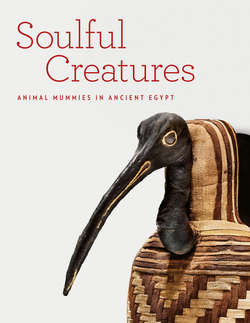Читать книгу Soulful Creatures - Edward Bleiberg - Страница 6
На сайте Литреса книга снята с продажи.
ОглавлениеPreface and Acknowledgments
Soulful Creatures: Animal Mummies in Ancient Egypt originated in the continuing effort to fully catalogue the contents of the Egyptian collection’s storage vaults at the Brooklyn Museum. In 2009, Kathy Zurek-Doule, Curatorial Assistant in the collection, uncovered thirty forgotten but neatly packed animal mummies in acid-free boxes. The boxes were on shelves of a small amount of uncatalogued material that the Museum originally purchased from the New-York Historical Society between 1937 and 1948. Although Brooklyn’s Egyptian collection is famous for the high quality of its works of art, the animal mummies represented a little-understood class of objects outside the realm of artworks per se. And so it seemed that this rediscovery of unexpected archaeological artifacts demanded its own course of study and exhibition. We are now eager to share the results of this work with Museum visitors.
The exhibition addresses choice examples from among the millions of mummies of birds, cats, dogs, snakes, and other animals preserved from at least thirty-one different cemeteries throughout Egypt. The objects, though numerous, are difficult to understand, because the ancient Egyptians did not leave us any written explanation of the role that animal mummies played in their religion, culture, or society. This exhibition and book therefore propose an interpretation of why the Egyptians made votive animal mummies and what they did with them in rituals. Our first principal essay, by Yekaterina Barbash, explores how animals were viewed in Egyptian thought and mythology, and provides the cultural context for the practice of animal mummy-making. My own essay then takes up the central role that animal mummies played in rituals of petition, as well as the social and economic aspects of these mummies, by examining documents preserved from the ibis sanctuary in Saqqara. Finally, the essay by Lisa Bruno uses scientific evidence derived from CT scans, X-rays, and carbon-14 dating to analyze precisely how animal mummies were made and what they contain, which produced some surprising results.
My co-curators, Yekaterina Barbash and Lisa Bruno, made working on this exhibition a special pleasure. I thank them for their creative engagement with the material, their patience, and their sense of humor.
Anthony Fischetti, DVM, MS, DACVR, of the Animal Medical Center in New York generously contributed his expertise in making and reading the project’s CT scans. We thank him for providing our team with one of our most exciting and fascinating research days as we first saw what was inside the unopened mummy wrappings.
Professor Salima Ikram of the American University in Cairo shared her unparalleled knowledge of animal mummies on several visits to Brooklyn over the last few years. Her insights were a great help to the team throughout the project.
The Brooklyn Museum’s Conservation Laboratory, under the leadership of Kenneth Moser, expertly prepared these rarely seen objects for exhibition. Special thanks go to Lisa Bruno, in her role as head Objects Conservator, and to her team, consisting of conservators Kathy Francis, Jakki Godfrey, Kerith Koss, Tina March, Joannie Bottkol, Erin Anderson, and Jessica Lian Pace. Additional important work was performed by the Conservation interns Lisa Ackerman, Kate Fugett, Emily Golan, Sara Levin, Cathie Magee, Alexis North, Anna Serotta, Jessica Walthew, and Victoria Werner.
The Exhibitions Division, managed by curator Sharon Matt Atkins, prepared the exhibition tour with great resourcefulness. Our thanks to Dolores Pukki Farrell for the arrangements she expertly made, and to curator Lisa Small, who worked as point person for the exhibition.
The excellent images in the book are the result of a special campaign of new photography, supervised by Deborah Wythe, Head of Digital Collections and Services, under difficult circumstances. Our thanks go to the photographers Sarah DeSantis, Christine Gant, and Gavin Ashworth for their skill, and to Collections Manager Walter Andersons and his team of art handlers for safely and expeditiously delivering art to the Digital Lab in record time.
James Leggio, Head of Publications and Editorial Services, provided a thoughtful sounding board and masterly editing for both the book and exhibition materials. He possesses an uncanny ability to understand what I mean to say before I know it myself.
Warm thanks go to Kathy Zurek-Doule, Curatorial Assistant to the Egyptian collection, whose invaluable support to the curators was always provided with patience and a smile. The project could not have been done without her.
Finally, I wish to thank Chief Curator Kevin Stayton, Director Arnold Lehman, Board Chair John S. Tamagni, Board President Stephanie Ingrassia, and the entire Board of Trustees for their support during the preparation of this unusual exhibition and book.
Edward Bleiberg
Curator of Egyptian Art
Brooklyn Museum
7
8
9
(see figure 74)
2. Detail of Seated Baboon
10
